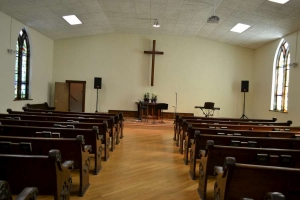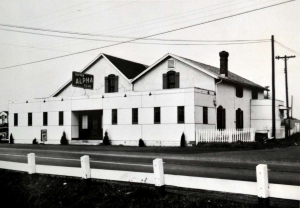
Brett Williford
Re-introducing you to the Beavercreek you love... from 1803 to today!
Note the uniqueness and charm of the architecture as you turn right and head through town! Alpha Church, on the east side of Alpha Road, was established in 1872 with our old friend Daniel Overholser, Sr. being a founder and early supporter.
In the past few years, the church has undergone extensive restoration with great attention paid to the tradition of it's founding.
The church is now a campus of the Beavercreek Church of the Nazarene. We'd like to extend a 'thank you' for their willingness to allow the Alpha Historic Society to maintain their archives in the lower level of the church!
 Alpha Church Restoration 1
Alpha Church Restoration 1
Alpha Church Restoration 1
Alpha Church Restoration 1
 Alpha Church Restoration 2
Alpha Church Restoration 2
Alpha Church Restoration 2
Alpha Church Restoration 2
 Alpha Church Restoration 3
Alpha Church Restoration 3
Alpha Church Restoration 3
Alpha Church Restoration 3
 Vacation Bible School
Vacation Bible School
Vacation Bible School
Vacation Bible School
 Vacation Bible School 1922
Vacation Bible School 1922
Vacation Bible School 1922
Vacation Bible School 1922
https://beavercreekliving.com/beavercreek-blog/itemlist/user/23-brettwilliford?start=90#sigProId04411267e9
Turn south on Alpha Drive, known long ago as Alpha-Shakertown Pike. The roads have been re-configured over the years. Alpha School #13, which was on the north side of Dayton-Xenia now sits on the south side.
Dr. George Anderson, a prominent local physician, lived in the first house on the south side of the intersection now known as Whitey Marshall Drive. The photo of Dr. Anderson below was taken Christmas Day, 1945 in the Marshall's home on Phil Hubbel Drive - the young boy is noted as Larry Mason.
Doc Anderson started the Alpha Dairy on the north side of Alpha, not far from the Beaver Grill. His son Horace, who lived across Factory Road from the 'Grill' was the primary operator of the dairy.
 Inset Map of Alpha, Ohio
Inset Map of Alpha, Ohio
Inset Map of Alpha, Ohio
Inset Map of Alpha, Ohio
 Alpha Dairy
Alpha Dairy
Alpha Dairy
Alpha Dairy
 Alpha School Attendees
Alpha School Attendees
Alpha School Attendees
Alpha School Attendees
 Alpha School #13
Alpha School #13
Alpha School #13
Alpha School #13
 Dr. George Anderson
Dr. George Anderson
Dr. George Anderson
Dr. George Anderson
https://beavercreekliving.com/beavercreek-blog/itemlist/user/23-brettwilliford?start=90#sigProIda1e27a76dc
Behind Beaver Cemetery sits the Jacob Coy House, now owned by Beavercreek Township. Five generations of Coy’s occupied the two-story log home built by Jacob in 1824. It originally sat at 3279 Shakertown Road in the middle of 3,000 acres Jacob had purchased in 1801.
Mainly through the efforts of Roger Coy, his great-great grandfather’s home was moved intact, on July 6, 1989 to its present location in Phillips Park. Protective siding has been installed and the basement of the structure has been modernized and is leased as the offices for the Beavercreek Wetlands Association. The main level was leased by the Beavercreek Historical Society until 2016 when they moved across the road to the former Beavercreek Township office building.
Please exit the parking lot to the right, returning west on Dayton-Xenia Road.
Founded in 1817 or 1818 by the Reverend Father Thomas Winters, the Beaver Congregation of the Reformed Church first met in old Father Coy’s barn and subsequently in the Coy’s School House. In 1820, the members tired of worshipping in barns and school houses, circulated subscription papers to construct a proper church. Not being able to agree on a location, they designated three options and whichever community raised the most subscription funds would win the right to choose the location. Ironically, the most central point, the northwest corner of George Long’s land, also garnered the largest subscribed amount
Over the course of many years, associated churches were formed by members of the Beaver Church congregation and ultimately kindred places of worship were constructed in Aley Church, Mt. Zion Church and also churches in Xenia and Byron.
It’s interesting to note that churches of the time were built by community, not denomination. Beaver Church was constructed by both the German Reformed Church and Lutheran congregations, holding their services on either alternate Sundays or at differing times on the same day. As communities and congregations grew, individual houses of worship were built.
We encourage you to walk Beaver Cemetery sometime; it is a veritable who’s who of the history of Beavercreek. Within the swag-chain perimeter are dozens of real-life stories of triumph, heartbreak and history. You’ll find recognize names on markers from this work, the Beavercreek Chronicles and even the roads you drive daily. Your respect is appreciated.
https://beavercreekliving.com/beavercreek-blog/itemlist/user/23-brettwilliford?start=90#sigProId1217d9a8f2
The Old Beaver Grade School - An Appreciation
By Bertha Trebein Flynn (c.1953)
The exact date of the erection of the Old Beaver School has grown dim with the passing of more than a half century (sic)since, long before its wrecking, it became a mute reminder of the past.
It stood not far from the Dayton Pike on a hill-slope just northwest of Beaver Church and, between 1850 and 1880 was a school of outstanding reputation in Greene County, attracting pupils from all parts of the County, including the county-seat.
It followed in imposing dignity two earlier structures, - the first, a log cabin much closer to "the pike," inadequately heated by a large fire-place at one end and provided in lieu of desks, with some crude boards, supported by heavy, sloping, wooden wall-pegs, before which pupils took turns in standing for written work. The second school building was a one-room brick structure, with a stove in the center, and with long, rough, backless benches facing rude boards fixed to the wall for holding slates, books and pencils.
Old Beaver's equipment, by comparison with its two predecessors, was comfortable and luxurious. It had individual seats at single or double desks with a space inside for books and possessions. Light fellin amply through the windows on bright days. Its original one-room was of necessity reserved after the first year or two for "the grades" and an "advanced room" was then added at the west with a front vestibule between, and an enclosed rear passage-way surmounted by a bell-tower with a bell of far-reaching resonance.
A remarkable curriculum was offered here for those aspiring to college: algebra, trigonometry, geometry, Greene's Analysis of the English Language, Latin, Greek, physics and - for the young men - the inevitable surveying. The head teacher was Mr. John W. Miller (father of the late Miss Louie Miller), who combined university training with a profound love of knowledge. So thorough was his work and that of his assistants that the students who completed the course at "Old Beaver" were able to enter the Sophomore Class at Miami University. Preparation for college grew in popularity.
For the grades there were the usual "practical" and mental arithmetic, geography, grammar, essays, spelling - now somewhat outmoded - "speeches," and the McGuffey Readers. Both Anna Snyder Perrin and Kate Snyder ("Miss Kate") gave real zest to their work, adding to it a generous use of nature's laboratory for the study of flowers and birds, - hours remembered with loving appreciation by some near-octogenarians today. (sic)
Two highly esteemed mentors of the "advanced" school's later years, who opened a new world to their pupils through their presentatin of poetry, biography, or history, were W. W. Donham and a Mr. Bonner whose initals elude memory and avalable records. One H. A. Nelson had distinguished himself and the school somewhat earlier through the staging of William Tell, for which suits of mail, sword, spears and other paraphernalia of ancient warfare were procured at what was for those times a considerable expense.
The school gave a good quota to the service in the Civil War. Five of the number achieved early captaincy: David Steele (father of the late J. D. Steele), William Glotfelter, Henry Herring, a Guthrie, and a Kirby.
"Old Beaver" closed its doors in 1882, when the march of sacrificial progress opened the local district schools of the Township.
Its years of activity remain an honored chapter in Greene County history.
Continue past Rotary Park, which is a naturally low area that was identified as a swamp in 1855 and a marsh in 1874, and occasionally floods yet today. Within the park you’ll find Owen’s Place, a universally accessible play and recreation area in a safe environment for individuals of all ages and ability levels.
Continuing east, you’ll pass the old barn at Phillips Park, formerly the John M. Weaver property. Turn left just beyond the cemetery into the parking lot at 1960 Dayton-Xenia Road of the Beaver United Church of Christ – affectionately known as Beaver Church.
 Gazebo at Phillips Park
Gazebo at Phillips Park
Gazebo at Phillips Park
Gazebo at Phillips Park
 Aerial of Owen's Place, Rotary Park
Aerial of Owen's Place, Rotary Park
Aerial of Owen's Place, Rotary Park
Aerial of Owen's Place, Rotary Park
 John M. Weaver Residence
John M. Weaver Residence
John M. Weaver Residence
John M. Weaver Residence
https://beavercreekliving.com/beavercreek-blog/itemlist/user/23-brettwilliford?start=90#sigProId7aa7d42c9a
The adjacent property, 2358 Dayton-Xenia Road, is affectionately known as The Old Stage Coach Inn. A popular stopping place between Yellow Springs and Dayton, it offered a livery stable for 12 to 14 horses. Built in 1810 by Frank Stoll, it is a modified Vernacular style. Built beside an Indian trail, and also thought to have been a slave trail, the house has a small dirt dugout with a small entrance door under the living room floor; it could have easily hidden three or four people.
Folklore includes a story of Abraham Lincoln once staying overnight at the inn while touring the area on his 1859 Presidential campaign, but research has proven this to be untrue. Lincoln's train did make a 5 minute whistle stop in Xenia before proceeding through Alpha enroute to Dayton, where he gave a sparsely attended speech at the courthouse. Later that evening, Lincoln delivered a modified speech in Cincinnati that changed the course of his campaign to become the sixteenth president of the United States.
In 1887, while the new high school was under construction, classes for the 20 pupils were held in an upstairs room of the Inn. In 1900, it was purchased as a blacksmith shop by Charly Johannes.
 Charly Johannes Receipt
Charly Johannes Receipt
Charly Johannes Receipt
Charly Johannes Receipt
 Marshall Brothers Ad
Marshall Brothers Ad
Marshall Brothers Ad
Marshall Brothers Ad
 Stagecoach House
Stagecoach House
Stagecoach House
Stagecoach House
 Stagecoach House And Family
Stagecoach House And Family
Stagecoach House And Family
Stagecoach House And Family
https://beavercreekliving.com/beavercreek-blog/itemlist/user/23-brettwilliford?start=90#sigProId7add6a246e
Next door to the Lone Pine was a supper club that was popular with local couples. In the mid-late 1940's it was a member's only establishment known as the Midnight Sun that allegedly offered some less-than-legal casino gaming. Stories have been shared that once or twice a year the Midnight Sun would be visited by the county law for an 'off-the-books' tax collection. In the 1950's it was open to the public as the Alpha Supper Club.
The building later played host to the VFW until they built across the street, and reportedly the Alpha Baptist Church held services there until their building on Beaver Valley Road was complete.
In the image, the road just visible ot the right of the image is Beaver Valley Road heading north from Dayton-Xenia. Looks like someone heading westbound on Dayton-Xenia struggled with the turn a bit, taking out a section of staves from the picket fence... more than one person has suggested it was likely Wendell 'Wendy' Marshall.
 Cyphers Marshall Accident
Cyphers Marshall Accident
Cyphers Marshall Accident
Cyphers Marshall Accident
 Midnight Sun Ad 1
Midnight Sun Ad 1
Midnight Sun Ad 1
Midnight Sun Ad 1
 Midnight Sun Ad 2
Midnight Sun Ad 2
Midnight Sun Ad 2
Midnight Sun Ad 2
 Midnight Sun Ad 3
Midnight Sun Ad 3
Midnight Sun Ad 3
Midnight Sun Ad 3
https://beavercreekliving.com/beavercreek-blog/itemlist/user/23-brettwilliford?start=90#sigProIdc9153342b6
In what is now the parking lot of the Wellington Grille was a seedy little roadside tavern known as the Lone Pine.
Stories have said that the Lone Pine was a fairly rough place that had a number of cabins behind that would often be rented nightly by those traveling the rail lines. They were also available weekly or monthly. Local ministers would inventory the vehicles in the parking lot during the weekend and then make mention of their findings at Sunday's service!
The county Sheriff once reported that he was tiring of collecting drunks, alive and otherwise, from in and around the cabins. A young lady was murdered in one of the cabins in the late 1940's, which was the end of the rentals...
The Lone Pine was later as The Road Runner. Typically, the person who managed the Lone Pine lived in a small home that was located between it and the supper club next door.
I have to share that in meetings with local senior citizens for the development of this project, the mere mention of the Lone Pine would bring about a wide range of emotion, from embarassment of it's existence to the occasional wry grin.
 The Lone Pine Cabins
The Lone Pine Cabins
The Lone Pine Cabins
The Lone Pine Cabins
 Knife Fight At The Lounge
Knife Fight At The Lounge
Knife Fight At The Lounge
Knife Fight At The Lounge
 Lone Pine Ad 1
Lone Pine Ad 1
Lone Pine Ad 1
Lone Pine Ad 1
 Fires At The Lone Pine
Fires At The Lone Pine
Fires At The Lone Pine
Fires At The Lone Pine
 Suicide Pact
Suicide Pact
Suicide Pact
Suicide Pact
 Lonesome Pine Filling Station
Lonesome Pine Filling Station
Lonesome Pine Filling Station
Lonesome Pine Filling Station
 Lone Pine Ad 3
Lone Pine Ad 3
Lone Pine Ad 3
Lone Pine Ad 3
 Lone Pine Ad 2
Lone Pine Ad 2
Lone Pine Ad 2
Lone Pine Ad 2
https://beavercreekliving.com/beavercreek-blog/itemlist/user/23-brettwilliford?start=90#sigProId59ce7ee58a
Life throughout Beavercreek Township during the latter nineteenth century was very agrarian, even in an urban metropolis like Alpha! While many families were very self-sufficient, growing their own crops and raising their own livestock, this was a transitional period for American capitalism. There was no 'free lunch', even amongst friends and family! From Daniel Overholser's writings, we've learned how different interpersonal relationships were:
- When invited to a friend's home for dinner, guests left a proportionate share of the cost of the meal for their hosts - typically $.75 to $1.50 per couple.
- If borrowing a neighbor's wagon to haul a load of fence rails from the sawmill, a rental fee was paid.
- Trading and bartering was commonplace, but written notes were exchanged upon incurring the debt, and destroyed upon satisfying it.
Familes certainly looked out for their own, but the church and community received a great deal of attention as well:
- During the Civil War, communities were able to raise 'subsciptions', which were essentially early war bonds. When reaching their township quota, families within were exempt from sending their youth to support the war effort. Often the entire town would show up at the Alpha or Xenia train stations to greet returning soldiers.
- Church wasn't a Sunday only activity. It was common to attend Bible study at the member's church, as well as to travel to local kindred churches. There was certainly more than a fair share of rivalry amongst churches 150 years ago as well!
- More recently, fire struck the Beaver Grill - many from the community gathered lumber and converged on the site to begin the rebuilding of the local icon.
One of Beavercreek's greatest attributes even today is our sense of community! When one of our residents suffers a loss or tragedy, we rise up to support them.
Latest Blog Posts
- Just Don't Call Us Late For Dinner...
- Remember When...
- What A Long, Strange Trip It's Been...
- Snow Down = Slow Down
- School Bus Safety - Just Do It!
- Stevenson Road Covered Bridge
- Our Road Crews Are Worth Their Salt!
- The Most Colorful Of Seasons!
- Popcorn Fest! - Then And Now
- Pre-School Paradise!
- Remembering Riffles
- Ten Year Anniversary Of The Beaver Statues














